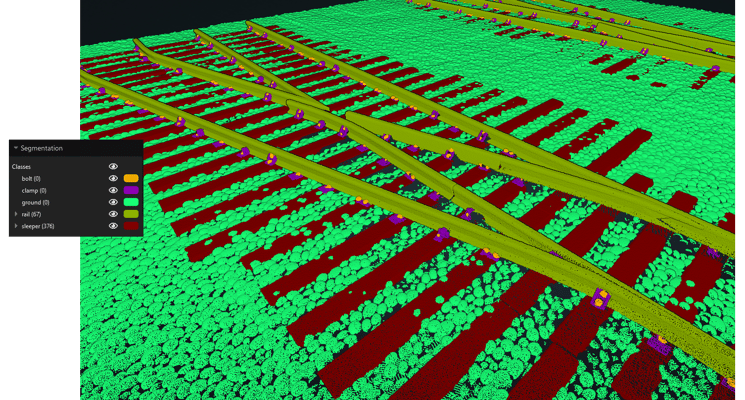Rail systems are increasing their focus on digitisation; the UK rail industry is refreshing its rail strategy, with one of the themes being better use of data. It is projected that the digital railway market will grow from US $50.0 billion in 2019 to US $100 billion by 2027, growing 9.7% annually during the forecast period, showing the dynamism of the area. Given this market environment, a progressive digital solution to an important operational requirement is a must and should be seen favourably as an important management and quality assurance process.
All railway and railroad infrastructure managers have to be content that their railway lines are maintained clear of any physical hazards to the trains/trams and are operational within safety tolerances. All have no alternative approach at present, there is a gap the market.
The Vercator Advantage
Vercator enables this safety inspection through the powerful AI-based segmentation service of point clouds. An engineering company was keen to inspect the track bolts and clips for movement and safety reporting. They had captured drone-based photogrammetry data that generated point clouds of the track to be inspected. The current workflow for inspection was manual, laborious, slow and open to interpretation as different inspectors made judgements about safety aspects. They wanted to see if this could be improved by automating the process and leveraging Vercator’s segmentation process to generate the information they needed.
Vercator’s rail segmentation model can classify a point cloud from lidar or photogrammetry into five key features: ground or ballast, sleeper, rail, clamp & bolt. This ability allows the picking up of small elements of interest, such as bolts, that are subject to safety concerns.
The Vercator segmentation runs fully automatically, providing results within minutes. Due to its scalable architecture, many datasets run in the same time as one, meaning that even the largest data is processed with ease. With the elements identified from segmentation they could then by used as the basis for change monitoring and asset management.
AI-based point cloud classification uses are currently growing in the construction sector, successfully providing companies with a user-friendly, reliable and effective service, therefore there are good reasons to consider that this innovation has a good chance of being successfully exploited in the rail infrastructure context, both on heavy rail, and with some small developments, with TfL and other metro and light rail operations. There will also be uses for this product in renewals and upgrade projects to enable clearance evaluation and verification of temporary or staged works, because of the significantly improved processing time.
Delivering this solution from the cloud brings with it the associated benefits of ease of access, scalable (and therefore fast) processing, data security and flexibility. Vercator, being cloud-based means, there is no requirement for the operator to invest in IT software or hardware, so the risk of obsolescence is removed, while the service is retained. The broad-based range of customers also supports longer-term development and commercial viability.
Rail Results and Uses
The outputs of Vercator’s processing allows engineers to move on from low-level work identifying structures and checking clearances to being able to focus on high added-value work, quality control and setting proactive intervention strategies on routes to either maintain or improve clearances, and to quickly and easily identify problem structures, or problems with track fixity. The results should also be applicable to the evaluation of tunnels, overbridges, OHE, catenary systems and cutting condition; there may be the opportunity to use it for vegetation assessments and some track faults. This development will significantly ease the pressure on engineers caused by the Scottish HLOS requirement.
Network Rail stated it could not affordably meet this requirement without this kind of technological development, likely to be the case for many of the other infrastructure managers in the EU and worldwide. Thus the commercial opportunity for this development is very significant. The GB rail network is a little over 10,000 miles or 16,000 km in length. The EU market is 15 times the size of the UK. The worldwide market is circa 100 times the size and so the impact is huge.
Try the Vercator cloud segmentation for yourself, or if you have a workflow challenge why not have a chat with us?



